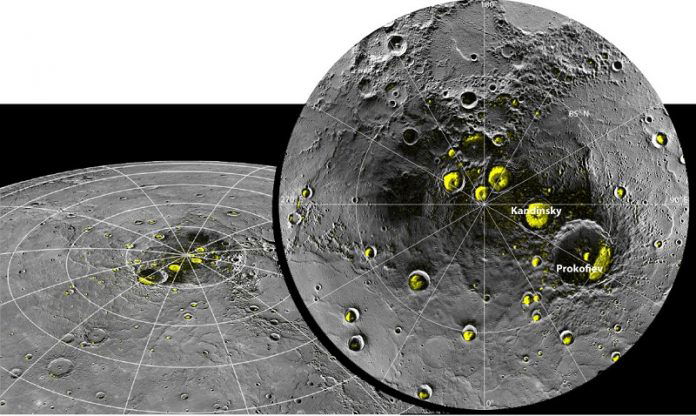
It is already hard to believe that there is ice on Mercury, where daytime temperatures reach 400 degrees Celsius, or 750 degrees Fahrenheit.
Now a recent study says that the Vulcan heat on the planet closest to the sun likely helps make some of that ice.
As with Earth, asteroids delivered most of Mercury’s water, the scientific consensus holds.
But the extreme daytime heat could be combining with the minus 200-degree Celsius cold in nooks of polar craters that never see sunlight to act as a gigantic ice-making chemistry lab, say researchers at the Georgia Institute of Technology.
The chemistry is not too complicated.
But the new study models it onto complex conditions on Mercury, including solar winds that pelt the planet with charged particles, many of which are protons key to that chemistry.
The model presents a feasible path for water to arise and collect as ice on a planet rife with all the necessary components.
“This is not some strange, out-of-left-field idea. The basic chemical mechanism has been observed dozens of times in studies since the late 1960s,” said Brant Jones, a researcher in Georgia Tech’s School of Chemistry and Biochemistry and the paper’s first author.
“But that was on well-defined surfaces. Applying that chemistry to complicated surfaces like those on a planet is groundbreaking research.”
Hot, simple chemistry
Minerals in Mercury’s surface soil contain what are called hydroxyl groups (OH), which are generated mainly by the protons.
In the model, the extreme heat helps to free up the hydroxyl groups, then energizes them to smash into each other to produce water molecules and hydrogen that lift off from the surface and drift around the planet.
Some water molecules are broken down by sunlight or rise far above the planet’s surface, but other molecules land near Mercury’s poles in permanent shadows of craters that shield the ice from the sun.
Mercury does not have an atmosphere and thus no air that would conduct heat, so the molecules become a part of the permanent glacial ice housed in the shadows.
“It’s a little like the song Hotel California. The water molecules can check in to the shadows but they can never leave,” said Thomas Orlando, a professor in Georgia Tech’s School of Chemistry and Biochemistry and the study’s principal investigator. Orlando co-founded the Georgia Tech Center for Space Technology and Research.
“The total amount that we postulate that would become ice is 1013 kilograms (10,000,000,000,000 kg or 11,023,110,000 tons) over a period of about 3 million years,” Jones said. “The process could easily account for up to 10 percent of Mercury’s total ice.”
The researchers published their results in Astrophysical Journal Letters.
The research was funded by the NASA Solar System Exploration Research Virtual Institute (SSERVI) program and the NASA Planetary Atmospheres program.
Written by Ben Brumfield.



